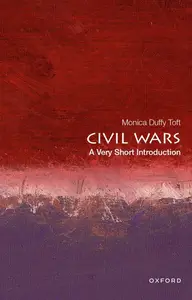
Free Download Civil Wars: A Very Short Introduction (Very Short Introductions) by Monica Duffy Toft
English | August 29th, 2024 | ISBN: 0197575862 | 169 pages | True PDF | 0.98 MB
Civil wars are nasty, brutish, and long. Monica Duffy Toft introduces this complex and timely topic.
Civil wars are the most common form of large-scale political violence. In the past thirty years, the study of civil wars has been one of the largest growing segments of the international relations field. Their causes are complex, ranging from fights over access to housing, jobs, and arable land or other resources, to political contests over offices, rights, and representation. Because civil wars tend to drag on, motives and relevant actors shift. Groups form, collapse, coalesce, align and realign, and then fight amongst themselves. Governments themselves change through elections, coups, military defeats, or revolutions. Understanding the origins of civil wars and their trajectories therefore demands some appreciation of the economic, political, social, cultural, and geographic order of societies.
If there is one factor that best predicts why a civil war erupts, it is a prior civil war. That is why knowledge of a country's history of political violence, and associated narratives about who is to blame and why, are critical to understanding where a civil war might next occur. Do insurgents deserve the title of freedom fighters or are they simply criminals or terrorists? If contested resources can be readily divided, how is it that seemingly rational actors so often treat them as indivisible? What is it about identity, or identities, that seem so irreconcilable that they so often lead to an escalation to violence-including violence against noncombatants-and the collapse of governments?
Theories about the causes, the nature, and the termination of civil wars have been adapted from both the international relations and comparative politics disciplines, and there are now many databases, cataloguing hundreds of cases of civil war, that enable sophisticated statistical analysis and formal modeling. As a result, we now have a better understanding of the conditions under which civil wars generally emerge, how the fighting evolves (sometimes involving interventions by external actors), and how civil wars end. However, historical understanding-the human dimensions-remain every bit as critical. This Very Short Introduction explores current debates on civil wars and how the reasons for fighting (and the nature of belligerents themselves) are changing.
